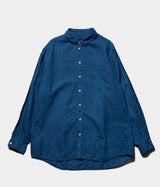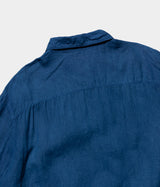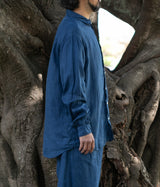MITTAN
MITTAN proposes modern ethnic clothing based on the history of clothing and fabrics left around the world.
By reinterpreting flat structures and combining them with the inherent functionality of natural materials, we aim to create clothes that will last for a long time, unfettered by the ephemeral trends of the times.
-Production background-
The fabrics used are mainly machine-woven fabrics from various parts of Japan such as Enshu, Banshu, and Bishu, as well as hand-woven fabrics from Asian countries such as India and Laos.
As much as possible, our designers go directly to the mill and work on developing unique materials.
In addition, we mainly use cotton thread for sewing thread, and natural materials for accessories such as woven labels, quality indicators, buttons, etc., and are sewn at our partner factories in Japan.
In addition to regular dyes, plants, indigo, insects, and minerals are used for dyeing, and the uneven color transitions are also seen as beauty.
-Regarding repairs to MITTAN products-
MITTAN's clothes are designed with the premise that they can be worn for a long time, not just for one season, and will continue to be worn even when the fabric starts to wear out. Therefore, we undertake repairs so that you can use it for a long time.
Please see below for details on repairs.
- Regarding the size of MITTAN -
MITTAN items can be worn by unisex.
Sizes are listed as 1, 2, and 3.
As a rough guide, 1 is M for women, 2 is M for men, and 3 is L for men.
Please choose the size according to your preference, whether you want to wear it compactly or slightly oversized.
RYUKYU INDIGO (Ryukyu indigo dyeing)
Ryukyu indigo, which has been cultivated in Okinawa since ancient times and was used as a dye for indigo dyeing, is an indispensable dye for Okinawan dyeing and weaving. The cultivation method is harsh, and in order to grow high-quality indigo leaves, thorough cultivation management and techniques are required, as well as strong physical and mental strength to withstand the hard labor involved in the indigo production process. In addition, many years of experience and hard work are required to determine the fermentation conditions and the amount of lime water used during the manufacturing stage.
By hand-dying each piece using indigo produced using a method that has been passed down from ancient times and carefully repeating the washing process, each piece has a unique texture and expression that cannot be achieved with chemical dyes. It has a different depth. Ryukyu indigo can be said to be the color of a deep culture similar to the beautiful ocean of Okinawa. However, as time passed and cheaply available chemically synthesized indigo became popular, fewer people were engaged in the labor-intensive work of indigo.
For more information on RYUKYU INDIGO, please see below.
About RYUKYU INDIGO
For more information on RYUKYU INDIGO, please see below.
About RYUKYU INDIGO
"SH-69RC" Cannabis shirt large (Ryukyu indigo dyeing)
Shirts are proposed as clothing that constitutes modern ethnic clothing. The composition follows the rules of clothing, but the design is stripped down as much as possible, and the pattern is based on functionality. Specifically, the sleeve hems are tucked in and the sleeve bottoms are set high to increase the amount of movement around the arms, and the back yoke is swarmed rather than tucked or gathered to ensure momentum in the back. It has an oversized and relaxed silhouette.
Shirts are proposed as clothing that constitutes modern ethnic clothing. The composition follows the rules of clothing, but the design is stripped down as much as possible, and the pattern is based on functionality. Specifically, the sleeve hems are tucked in and the sleeve bottoms are set high to increase the amount of movement around the arms, and the back yoke is swarmed rather than tucked or gathered to ensure momentum in the back. It has an oversized and relaxed silhouette.
The fabric uses 100% hemp thread for the warp and weft. Hemp is a strong fiber, but over time it gradually adapts to your skin, allowing you to enjoy the change in texture from linen to cotton. The cool feel that is characteristic of cannabis remains even after repeated washing, making it comfortable to wear even in the middle of summer.
size (cm)
2/ Length 79.5 Shoulder width 49 Sleeve length 60 Width 58
3 / Length 83.5 Shoulder width 51 Sleeve length 64 Width 63
Model wearing: 178cm Wearing size: 3
Model wearing: 178cm Wearing size: 3
Material: 100% plant fiber (hemp)
Made in Japan
Made in Japan
<Please be aware of the following as it is a characteristic of the product before purchasing>
・As it is hand-dyed, there may be individual differences.
Please enjoy the uneven color transitions as a result of natural dyeing. The unique unevenness is the biggest feature that cannot be expressed with chemical dyes.
・Please note that indigo-dyed products are naturally dyed, so there is a possibility of color transfer the first few times you wear them. In order to prevent these problems, we have applied color fixing, but please be aware that this is due to the nature of natural dyeing.
・Please store in a place where it is not exposed to sunlight as it can easily get sunburned.
- When the product arrives, the lye characteristic of indigo dyeing may float on the surface, causing an odor and a yellow-brown color. In that case, please clean it as described below before wearing it. The scum will be removed and the vivid color that is unique to natural indigo dyeing will increase.
Daily care
- Wash gently with water, or if possible, by hand.
・Please dry in the shade to prevent sunburn.
・Please avoid dry cleaning.
-Please wash separately from other clothes for the first few times. Color transfer may occur.
・After that, wash with dark colored items or wash separately.
- It is recommended that you use a neutral detergent that does not contain bleach or optical brighteners. Alternatively, please use a special detergent that does not easily fade.
First time care (how to remove scum)
*We recommend soaking it in hot water once every 1 to 3 months to remove the scum.
① Place the product in hot water at around 40℃ for 20 to 30 minutes.
② When the scum appears, it becomes yellowish brown. If there is excess indigo left, a blue color will appear.
③ Wash 2 to 3 times, changing the water.
④Repeat steps 1 to 3 twice.
⑤ Thoroughly dehydrate and dry.
・Removal of scum is the removal of impurities other than indigo contained in indigo.
The original indigo color of indigo dyeing stands out and has the effect of reducing fading caused by ultraviolet rays.
・There may be some blue dye on the surface of the bowl or sink used for washing, but it will come off if you rub it with a sponge.
























